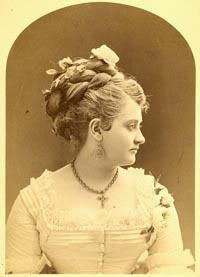Galloping Horse - 1878
Eadweard Muybridge (1830-1904) revolutionised photography. He is best known for his seminal work Animal Locomotion where he documented both humans and animals in motion. This body of work, initially began with a wager from one of Muybridges patrons in 1877 that a Horse does not at any one time have his feet off the ground while galloping. While this work is his most famous and has influenced photography, cinema and science for more than a century, the current Tate Britain retrospective (the first of this kind in the UK ans finishing on 16th January) has highlighted some other interesting facts about Eadweard Muybridge that you may not already know.
 1 He changed his name more than his facial hair.
1 He changed his name more than his facial hair.
Eadweard Muybridge
People commonly mistake his name to be Edward Mybridge, but his name was just as much changed and mistaken during his own lifetime. He was born Edward James Muggeridge, has been listed as Muggeridge and Muygridge after moving to America, revised it to Edwardo Santiago Maybridge while in central America, changed his first name to Eduardo after a Saxon King, and was conferred as Professor Muybridge. The last form on his gravestone is Eadweard Muybridge. He also published some of his work under the name Helios. One thing that never changed though, was his beard. Apart from when he went grey.
2 He was acquitted for the Murder of his wife’s lover.
 In 1891, Muybridge married 19 year-old divorce Flora Stone, who was over 20 years his junior. Three years later she bore a child, Floredo Helious Muybridge. At first the child’s paternity was never in question, but as Muybridge spent many long periods away from home he eventually became suspicious that he may not be the child’s father. When his suspicions were confirmed, he then went and shot Harry Larkyns, Flora’s lover.
In 1891, Muybridge married 19 year-old divorce Flora Stone, who was over 20 years his junior. Three years later she bore a child, Floredo Helious Muybridge. At first the child’s paternity was never in question, but as Muybridge spent many long periods away from home he eventually became suspicious that he may not be the child’s father. When his suspicions were confirmed, he then went and shot Harry Larkyns, Flora’s lover.
As Muybridge was a minor celebrity in San Francisco at the time, the murder and trial caused a scandal. However, Muybridge was acquitted for the crime on the grounds of justifiable homicide for what he had discovered. Flora asked for a divorce but she mysteriously died of Typhoid soon after the trial, and Floredo was sent to an orphanage.
The story is very Sunset Beach, and was fictionalised in an opera by Phillip Glass in 1982 entitled The Photographer.
3 He created two panoramas of San Francisco, one seventeen foot long.
 Muybridge created two Panaromas of San Francisco, the city he was largely based in during his time in America. A fire destroyed the glass plate negatives of the first panorama created in 1877, so Muybridge set about creating another Panorama a year later. It is estimated that it took 15-25 minutes to to expose each of the 13 glass plates.
Muybridge created two Panaromas of San Francisco, the city he was largely based in during his time in America. A fire destroyed the glass plate negatives of the first panorama created in 1877, so Muybridge set about creating another Panorama a year later. It is estimated that it took 15-25 minutes to to expose each of the 13 glass plates.4 Francis Bacon owned four copies of Humans in Motion.
Many of Muybridges stills served as inspirations for Francis Bacon’s own work, who always drew from photographs. Muybridges studies of motion drew countless inspiration for other Artists including Edgar Degas and Marcel Duchamp.
5 Muybridge also documented a Baboon in motion.
I had to finish with a red arse.

 05:39
05:39
 SIP Enterprises
SIP Enterprises



 Posted in:
Posted in: 



0 comments:
Post a Comment